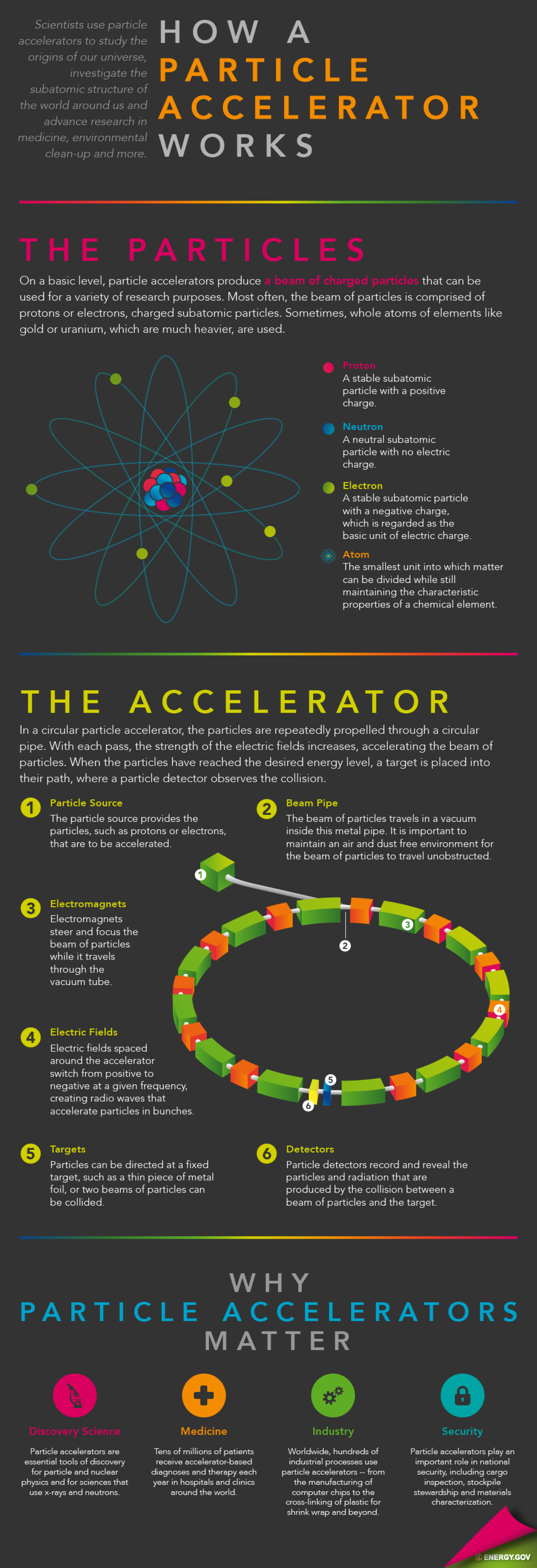As part of our How Energy Works series, this blog explains how particle accelerators work.
June 18, 2014
Infographic by <a href="/node/379579">Sarah Gerrity</a>, Energy Department.
Whether it’s medical or scientific research, consumer product development or national security, particle accelerators touch nearly every part of our daily lives. Since the early days of the cathode ray tube in the 1890s, particle accelerators have made important contributions to scientific and technological innovation. Today, there are more than 30,000 particle accelerators in operation around the world.
What is a particle accelerator?
A particle accelerator is a machine that accelerates elementary particles, such as electrons or protons, to very high energies. On a basic level, particle accelerators produce beams of charged particles that can be used for a variety of research purposes. There are two basic types of particle accelerators: linear accelerators and circular accelerators. Linear accelerators propel particles along a linear, or straight, beam line. Circular accelerators propel particles around a circular track. Linear accelerators are used for fixed-target experiments, whereas circular accelerators can be used for both colliding beam and fixed target experiments.
How does a particle accelerator work?
Particle accelerators use electric fields to speed up and increase the energy of a beam of particles, which are steered and focused by magnetic fields. The particle source provides the particles, such as protons or electrons, that are to be accelerated. The beam of particles travels inside a vacuum in the metal beam pipe. The vacuum is crucial to maintaining an air and dust free environment for the beam of particles to travel unobstructed. Electromagnets steer and focus the beam of particles while it travels through the vacuum tube.
Electric fields spaced around the accelerator switch from positive to negative at a given frequency, creating radio waves that accelerate particles in bunches. Particles can be directed at a fixed target, such as a thin piece of metal foil, or two beams of particles can be collided. Particle detectors record and reveal the particles and radiation that are produced by the collision between a beam of particles and the target.
How have accelerators contributed to basic science?
Particle accelerators are essential tools of discovery for particle and nuclear physics and for sciences that use x-rays and neutrons, a type of neutral subatomic particle.
Particle physics, also called high-energy physics, asks basic questions about the universe. With particle accelerators as their primary scientific tools, particle physicists have achieved a profound understanding of the fundamental particles and physical laws that govern matter, energy, space and time.
Over the last four decades, light sources -- accelerators producing photons, the subatomic particle responsible for electromagnetic radiation -- and the sciences that use them have made dramatic advances that cut across many fields of research. Today, there are now about 10,000 scientists in the United States using x-ray beams for research in physics and chemistry, biology and medicine, Earth sciences, and many more aspects of materials science and development.
How have particle accelerators improved consumer products?
Worldwide, hundreds of industrial processes use particle accelerators -- from the manufacturing of computer chips to the cross-linking of plastic for shrink wrap and beyond.
Electron-beam applications center on the modification of material properties, such as the alteration of plastics, for surface treatment, and for pathogen destruction in medical sterilization and food irradiation. Ion-beam accelerators, which accelerate heavier particles, find extensive use in the semiconductor industry in chip manufacturing and in hardening the surfaces of materials such as those used in artificial joints.
How are particle accelerators used in medical applications?
Tens of millions of patients receive accelerator-based diagnoses and therapy each year in hospitals and clinics around the world. There are two primary roles for particle accelerators in medical applications: the production of radioisotopes for medical diagnosis and therapy, and as sources of beams of electrons, protons and heavier charged particles for medical treatment.
The wide range of half-lives of radioisotopes and their differing radiation types allow optimization for specific applications. Isotopes emitting x-rays, gamma rays or positrons can serve as diagnostic probes, with instruments located outside the patient to image radiation distribution and thus the biological structures and fluid motion or constriction (blood flow, for example). Emitters of beta rays (electrons) and alpha particles (helium nuclei) deposit most of their energy close to the site of the emitting nucleus and serve as therapeutic agents to destroy cancerous tissue.
Radiation therapy by external beams has developed into a highly effective method for treating cancer patients. The vast majority of these irradiations are now performed with microwave linear accelerators producing electron beams and x-rays. Accelerator technology, diagnostics and treatment technique developments over the past 50 years have dramatically improved clinical outcomes. Today, 30 proton and three carbon-ion-beam treatment centers are in operation worldwide, with many new centers on the way.
The Energy Department's National Labs played a crucial role in the early development of these technologies. Los Alamos National Laboratory helped develop linear accelerators for electrons, now the workhorses of external-beam therapy. Oak Ridge and Brookhaven National Laboratories contributed much of the present expertise in isotopes for diagnosis and therapy. Lawrence Berkeley National Laboratory pioneered the use of protons, alpha particles (helium nuclei) and other light ions for therapy and radiobiology.
How have particle accelerators benefited national security?
Particle accelerators play an important role in national security, including cargo inspection, stockpile stewardship and materials characterization.
Early applications of accelerators to inspect nuclear fuels used commercial low-energy electron linear accelerators to induce photo-fission reactions. These inspection technologies expanded to waste-drum investigation in the 1980s and eventually to cargo inspections. The invention of the free electron laser in the 1970s led to ever-higher-power electromagnetic radiation using high-energy electrons, of direct interest to security and defense applications, including the Navy’s proposed application of free-electron laser technology to shipboard defense.


